 |
|
|
plants text index | photo
index
|
| coastal plants |
| Beach
morning glory Ipomoea pes-caprae Family Convolvulaceae updated Jan 13 Where seen? With fresh green leaves and bright purple flowers, this creeper is sometimes seen growing wild on our sandy beaches, at the highest water mark. This plant is found on tropical shores everywhere including throughout Southeast Asia. It belongs to the Family Convolvulaceae which includes the more commonly seen terrestrial morning glory, as well as our favourite vegetable Kang kong (Ipomoea reptans) and sweet potato or Keladi (Ipomoea batatas). Features: A creeper that grows on the sand, taking root at the nodes and having thick, deep tap roots. The leaves rather thick and fleshy, in varying shapes and sizes (3-10cm), according to Hsuang Keng from oval to quadrangular to rounded. They may be deeply lobed or only notched at the end. Sometimes they form two lobes that resembles a goat's or horse's hoof. The Malay name of the plant 'Tapak Kuda' means 'horse's footprint', while the scientific name 'pes-caprae' means 'goat's foot'. Flowers large trumpet-shaped (3-5cm) thin delicate, usually pink, reddish purple or violet, and usually darker at the base, rarely white. Flowers open early in the morning and shrivel by the afternoon. Fruit ripens to a small (about 1cm) globular, dry capsule which explodes to release four black, densely hairy seeds. The seeds float and are resistant to salt water, and dispersed by sea. Role in the habitat: According to Polunin, is the most important coloniser of many tropical beaches around the world. Its creeping rooting stems often form dense patches which hold down the sand and produce humus. Human uses: According to Wee, the juice squeezed from the plant is used in Malaysia to treat fish stings. The leaves are used in Indonesia to hasten the bursting of boils; sap from the young leaves are boiled in coconut juice and used to treat sores and ulcers; and the seeds chewed with areca nut, soothe abdominal pains and cramps. In the Philippines, the boiled leaves are used to treat rheumatism. While Polunin records its use as a purgative in Malay medicine. Burkill includes the use of boiled tubers to relieve bladder problems as they have a diuretic effect. According to Burkill, animals will eat the leaves but they will taint the milk of cows. The leaves are also fed to pigs. |
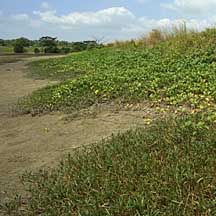 Pulau Semakau, Jan 09 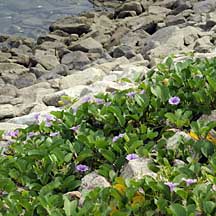 Pulau Semakau, Apr 09 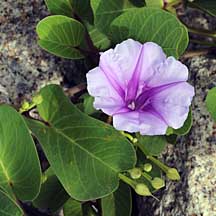 Pulau Semakau, Apr 09 |
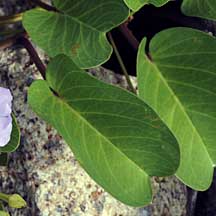 Lobed leaf may resemble a hoof print. Pulau Semakau, Jan 09 |
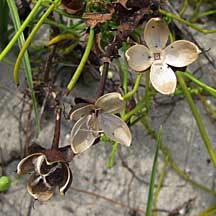 Opened fruit capsules. Changi, Jan 10 |
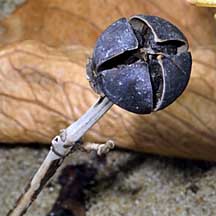 Fruit capsule. Pulau Semakau, Jan 09 |
Beach morning glory on Singapore shores
| Photos for free download from wildsingapore flickr |
|
Links
References
|
|
|